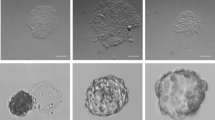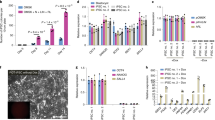Abstract
Human embryonic stem cells (HESC) can potentially generate every body cell type, making them excellent candidates for cell- and tissue-replacement therapies. HESC are typically cultured with animal-derived 'serum replacements' on mouse feeder layers. Both of these are sources of the nonhuman sialic acid Neu5Gc, against which many humans have circulating antibodies. Both HESC and derived embryoid bodies metabolically incorporate substantial amounts of Neu5Gc under standard conditions. Exposure to human sera with antibodies specific for Neu5Gc resulted in binding of immunoglobulin and deposition of complement, which would lead to cell killing in vivo. Levels of Neu5Gc on HESC and embryoid bodies dropped after culture in heat-inactivated anti-Neu5Gc antibody–negative human serum, reducing binding of antibodies and complement from high-titer sera, while allowing maintenance of the undifferentiated state. Complete elimination of Neu5Gc would be likely to require using human serum with human feeder layers, ideally starting with fresh HESC that have never been exposed to animal products.
This is a preview of subscription content, access via your institution
Access options
Subscribe to this journal
Receive 12 print issues and online access
$209.00 per year
only $17.42 per issue
Buy this article
- Purchase on Springer Link
- Instant access to full article PDF
Prices may be subject to local taxes which are calculated during checkout





Similar content being viewed by others
References
D'Amour, K. & Gage, F. H. New tools for human developmental biology. Nat. Biotechnol. 18, 381–382 (2000).
Keller, G. & Snodgrass, H. R. Human embryonic stem cells: the future is now. Nat. Med. 5, 151–152 (1999).
Bradley, J. A., Bolton, E. M. & Pedersen, R. A. Stem cell medicine encounters the immune system. Nat. Rev. Immunol. 2, 859–871 (2002).
Thomson, J. A. et al. Embryonic stem cell lines derived from human blastocysts. Science 282, 1145–1147 (1998).
Amit, M. et al. Clonally derived human embryonic stem cell lines maintain pluripotency and proliferative potential for prolonged periods of culture. Dev. Biol. 227, 271–278 (2000).
Draper, J. S., Moore, H. D., Ruban, L. N., Gokhale, P. J. & Andrews, P. W. Culture and characterization of human embryonic stem cells. Stem Cells Dev. 13, 325–336 (2004).
Koivisto, H. et al. Cultures of human embryonic stem cells: serum replacement medium or serum-containing media and the effect of basic fibroblast growth factor. Reprod Biomed Online 9, 330–337 (2004).
Itskovitz-Eldor, J. et al. Differentiation of human embryonic stem cells into embryoid bodies compromising the three embryonic germ layers. Mol. Med. 6, 88–95 (2000).
Carpenter, M. K., Rosler, E. & Rao, M. S. Characterization and differentiation of human embryonic stem cells. Cloning Stem Cells 5, 79–88 (2003).
Conley, B. J., Young, J. C., Trounson, A. O. & Mollard, R. Derivation, propagation and differentiation of human embryonic stem cells. Int. J. Biochem. Cell Biol. 36, 555–567 (2004).
Chou, H. H. et al. A mutation in human CMP-sialic acid hydroxylase occurred after the Homo-Pan divergence. Proc. Natl. Acad. Sci. USA 95, 11751–11756 (1998).
Varki, A. Loss of N-glycolylneuraminic acid in humans: mechanisms, consequences and implications for hominid evolution. Yearb. Phys. Anthropol. 44, 54–69 (2002).
Tangvoranuntakul, P. et al. Human uptake and incorporation of an immunogenic nonhuman dietary sialic acid. Proc. Natl. Acad. Sci. USA 100, 12045–12050 (2003).
Bardor, M., Nguyen, D.H., Diaz, S. & Varki, A. Mechanism of uptake and incorporation of the non-human sialic acid N-glycolneuraminic acid into human cells. J. Biol. Chem. published online 29 November 2004 <http://www.jbc.org/cgi/reprint/M412040200v2>
Richards, M., Fong, C. Y., Chan, W. K., Wong, P. C. & Bongso, A. Human feeders support prolonged undifferentiated growth of human inner cell masses and embryonic stem cells. Nat. Biotechnol. 20, 933–936 (2002).
Richards, M. et al. Comparative evaluation of various human feeders for prolonged undifferentiated growth of human embryonic stem cells. Stem Cells 21, 546–556 (2003).
Nakashima, K., Colamarino, S. & Gage, F. H. Embryonic stem cells: staying plastic on plastic. Nat. Med. 10, 23–24 (2004).
Rosler, E. S. et al. Long-term culture of human embryonic stem cells in feeder-free conditions. Dev. Dyn. 229, 259–274 (2004).
Amit, M., Shariki, C., Margulets, V. & Itskovitz-Eldor, J. Feeder layer- and serum-free culture of human embryonic stem cells. Biol. Reprod. 70, 837–845 (2004).
Draper, J. S. et al. Recurrent gain of chromosomes 17q and 12 in cultured human embryonic stem cells. Nat. Biotechnol. 22, 53–54 (2004).
Cheng, L., Hammond, H., Ye, Z., Zhan, X. & Dravid, G. Human adult marrow cells support prolonged expansion of human embryonic stem cells in culture. Stem Cells 21, 131–142 (2003).
Hovatta, O. et al. A culture system using human foreskin fibroblasts as feeder cells allows production of human embryonic stem cells. Hum. Reprod. 18, 1404–1409 (2003).
Miyamoto, K. et al. Human placenta feeder layers support undifferentiated growth of primate embryonic stem cells. Stem Cells 22, 433–440 (2004).
Yamaguchi, M. et al. Bone marrow stromal cells prepared using AB serum and bFGF for hematopoietic stem cells expansion. Transfusion 42, 921–927 (2002).
Badcock, G., Pigott, C., Goepel, J. & Andrews, P. W. The human embryonal carcinoma marker antigen TRA-1-60 is a sialylated keratan sulfate proteoglycan. Cancer Res. 59, 4715–4719 (1999).
Zhang, S. C., Wernig, M., Duncan, I. D., Brustle, O. & Thomson, J. A. In vitro differentiation of transplantable neural precursors from human embryonic stem cells. Nat. Biotechnol. 19, 1129–133 (2001).
Reubinoff, B. E. et al. Neural progenitors from human embryonic stem cells. Nat. Biotechnol. 19, 1134–1140 (2001).
Dubois, C., Manuguerra, J.-C., Hauttecoeur, B. & Maze, J. Monoclonal antibody A2B5, which detects cell surface antigens, binds to ganglioside GT3 (II3 (NeuAc)3LacCer) and to its 9-O-acetylated derivative. J. Biol. Chem. 265, 2797–2803 (1990).
Cowan, C. A. et al. Derivation of embryonic stem-cell lines from human blastocysts. N. Engl. J. Med. 350, 1353–1356 (2004).
Gearhart, J. New human embryonic stem-cell lines—more is better. N. Engl. J. Med. 350, 1275–1276 (2004).
Zufferey, R., Nagy, D., Mandel, R. J., Naldini, L. & Trono, D. Multiply attenuated lentiviral vector achieves efficient gene delivery in vivo. Nat. Biotechnol. 15, 871–875 (1997).
Author information
Authors and Affiliations
Corresponding author
Ethics declarations
Competing interests
The authors declare no competing financial interests.
Rights and permissions
About this article
Cite this article
Martin, M., Muotri, A., Gage, F. et al. Human embryonic stem cells express an immunogenic nonhuman sialic acid. Nat Med 11, 228–232 (2005). https://doi.org/10.1038/nm1181
Received:
Accepted:
Published:
Issue Date:
DOI: https://doi.org/10.1038/nm1181
This article is cited by
-
Stem Cell-Based Tissue Engineering Approaches for Diabetic Foot Ulcer: a Review from Mechanism to Clinical Trial
Stem Cell Reviews and Reports (2024)
-
Optimization of bovine embryonic fibroblast feeder layer prepared by Mitomycin C
Cell and Tissue Banking (2023)
-
Development and evaluation of a novel xeno-free culture medium for human-induced pluripotent stem cells
Stem Cell Research & Therapy (2022)
-
Comparative analysis of mesenchymal stem cells cultivated in serum free media
Scientific Reports (2022)
-
Immune disguise: the mechanisms of Neu5Gc inducing autoimmune and transplant rejection
Genes & Immunity (2022)



